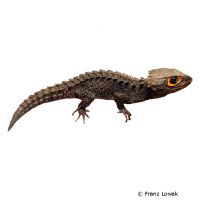Red-eyed Crocodile Skink (Tribolonotus gracilis)
| Red-eyed Crocodile Skink Tribolonotus gracilis | |
|---|---|
| Name | Red-eyed Crocodile Skink |
| Name Lat. | Tribolonotus gracilis |
| Family | Skinks |
| Family lat. | Scincidae |
| Order | Scaled Reptiles |
| Order lat. | Squamata |
| Origin | New Guinea |
| Habitat | Rainforests |
| Diet | Insects |
| Humidity | 70-90 % |
| Behavior | Nocturnal, ♂ territorial |
| Keeping | Individual, pair |
| Care Level | Experts only |
| Reproduction | Oviparous |
| Housing | Humid terrarium |
| Life Span | 10-15 years |
| Protection | EU Annex D |
| Metric Units | |
| Size | 17-20 cm |
| Temperature | 22-25 °C |
| Temperature Local | 28 °C |
| Housing Size | 100 x 60 x 60 cm |
| US Units | |
| Size | 6.7"-8" |
| Temperature | 72-77 °F |
| Temperature Local | 82 °F |
| Housing Size | 40" x 25" x 25" |
Distribution and habitat
Predominantly crepuscular to nocturnal, Orange-eyed Helmeted Skinks are native to New Guinea and neighboring islands. They live in tropical rainforests near bodies of water, where they are usually found hiding under foliage and roots. Adult animals are considered good swimmers.
Maintenance
Recommended minimum dimensions for the terrarium, according to the size and number of animals
| 1-2 animals | 5KRL x 4KRL x 4KRL (L x W x H) |
Head-torso length (KRL) is measured on the largest animal. For each additional animal, increase the footprint by 15%. Ideal is a terrarium of e.g. L 100 x W 60 x H 60 cm for 2-3 animals, which should be placed in a quiet and vibration-free place
They need a humid terrarium with flat climbing branches, stone structures (hiding places, visual protection) and structured back and side walls (e.g. cork covering) as well as a shallow water bowl and a deep substrate for digging. Terrarium humus or a soil-peat mixture covered with some foliage and bark mulch is suitable for this, as well as planting for decoration (ficus, ferns, mosses, etc.). The substrate should always be kept slightly moist. Several times a day the inside of the terrarium should be finely sprayed with water (humidity), but better is a rain or fog system
| Temp. day: 22-25 °C | Temp. night: 20-22 °C | Temp. local: up to 28 °C | Humidity: 70-90 |
The lighting duration must be 12-14 hrs. Daylight fluorescent tubes supplemented with special lamps that produce the necessary heat and UV light are ideal.
Diet
The food supply consists of live insects such as crickets, house crickets, grasshoppers, beetles, spiders, zophobas, etc. Ready-made food for insectivorous reptiles is also frequently accepted. Wax moths should rarely be fed in very small quantities because of their large fat content. The quality of the feed can be enhanced by feeding overripe fruit and honey water. It is important to add minerals and vitamins regularly (e.g. by dusting the feeders). Young animals should be offered food daily, adults 4-5 times a week. Water must always be available
A varied diet promotes health and prevents deficiency symptoms.
Reproduction and breeding
The males have a larger head and clearly larger scales on the underside of the hind feet, which the females lack entirely. A reliable sex determination is only possible by testosterone determination or endoscopy.
They are oviparous and a clutch consists of only one egg. The incubation period is 55-60 days at a temperature of 24-25 °C. Several clutches per season are possible. Suitable initial food is small insects such as fruit flies, aphids, micro-unicates, etc
Species protection
Species protection: EU Appendix D, monitoring of trade relevance (monitoring)
Your pet store will be happy to provide you with further information.
Important
Pair keeping is sometimes difficult. Group keeping is only possible in a much larger and richly structured terrarium. Although mainly ground dwelling they like to climb.
Temperatures above 25 °C are tolerated only for a short time. They are particularly sensitive to dehydration. It is to be made sure that no stagnant moisture forms and the substrate does not sump.
Before buying, knowledge about biology and keeping of the animal should be acquired as well as an appropriate terrarium should be prepared, which corresponds to the species-specific needs. Necessary is good ventilation without drafts, as well as equipment for measuring temperature and humidity. The lighting must correspond to the species-specific day-night rhythm and must be placed in such a way that the animals cannot injure themselves. The terrarium should be locked in such a way that neither unauthorized persons can open it nor the animals can escape. Contamination must be removed regularly
Further literature can be found in your pet store.
References
Text: petdata; Image: Franz Lowak
Source: ENGELMANN (2006): Zootierhaltung - Tiere in menschlicher Obhut: Reptilien und Amphibien, Harri Deutsch Verlag; BMELV (1997): Mindestanforderungen an die Haltung von Reptilien
- Gemäß § 21 Abs. 5 Tierschutzgesetz idgF
